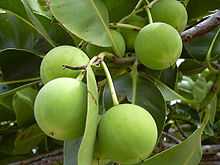Tamanu oil

Tamanu oil is a natural topical healing agent with skin healing, antineuralgic, anti-inflammatory, antimicrobial, antibiotic, and antioxidant properties. It is pressed from nuts of either the Calophyllum inophyllum (usually) or the Calophyllum tacamahaca tree.
Origins
The tamanu tree is indigenous to tropical Southeast Asia; it is found in Thailand, Vietnam, Myanmar, Malaysia, South India, Sri Lanka, and the Melanesian and Polynesian islands. It grows up to three meters tall, sporting cracked, black bark and elliptical, shiny leaves. The tamanu tree blooms twice annually with fragrant, white flowers, which later yield clusters of yellow-skinned spherical fruit. The fruit’s pulp tastes similar to an apple, within which a large nut is embedded. The nut contains an odorless pale kernel, called punnai in some Pacific areas. This kernel is dried in the sun for two months until it becomes sticky with a dark, thick, rich oil; it must be protected from humidity and rain during drying.
Usage for Skin Care
Tamanu oil possesses a unique capacity to promote the formation of new tissue, thereby accelerating wound healing and the growth of healthy skin. This process is known as cicatrization. For this reason, it is a widely used traditional topical aid. In Pacific island folk medicine, tamanu oil is applied liberally to cuts, scrapes, burns, insect bites and stings, abrasions, acne and acne scars, psoriasis, diabetic sores, anal fissures, sunburn, dry or scaly skin, blisters, eczema, herpes sores, and to reduce foot and body odor. Tamanu oil is also massaged into the skin to relieve neuralgia, rheumatism and sciatica. Tamanu oil is employed by Polynesian women for promoting healthy, clear, blemish-free skin, and is also used on babies to prevent diaper rash and skin eruptions. [1] [2]
Oil of tamanu is suitable for general skin and cosmetic purposes. The oil’s unusual absorption, its mild and pleasant aroma, and its luxurious feel make it ideal for use in lotions, creams, ointments and other cosmetic products. Considering that tamanu is a potent healing agent with proven benefits, it is only a matter of time before tamanu breaks through to more widespread use, and assumes a position among other successful topical and cosmetic ingredients.
Constituents in Tamanu Oil
Oil of tamanu contains three basic classes of lipids, neutral lipids, glycolipids, and phospholipids. The oil also contains a unique fatty acid called calophyllic acid, and a novel antibiotic lactone and non-steroidal anti-inflammatory agent called calophyllolide. These and other components of tamanu oil, including anti-inflammatory coumarins, account for some of the oil’s beneficial activity.
Based on the known activity of known constituents, it is clear that oil of tamanu possesses antibacterial and anti-inflammatory activities. The unique cicatrizing properties of tamanu oil are not yet explained in existing scientific literature, though this activity is established and accepted. The same is true for tamanu’s anti-neuralgic properties. Tamanu oil is well documented for its relief of neuritis, but the constituents responsible and their modes of activity are not yet known.
The oil contains the following fatty acids:
| Fatty acid | Content |
|---|---|
| Linoleic acid | 38% |
| Oleic acid | 34% |
| Stearic acid | 13% |
| Palmitic acid | 12% |
MAIN ACTIVE INGREDIENTS: Calophyllolide, Lactone
OTHER ACTIVE INGREDIENTS: Friedelin, Inophyllums B and P, Terpenic essences, Benzoic and 0xi-benzoic Acids, Phospho-amino- lipids, Glycerides, Saturated fatty acids 4-Phenylcoumarins [3]
How Tamanu Oil is Produced
Calophyllum inophyllum is indigenous to Southeast Asia, but is profuse in Polynesia. The tree grows up to 25 or even 30 meters in height, with long, spreading limbs. The tree trunk is typically thick with dark, cracked bark. The tamanu branches are covered with shiny, dark green oval leaves, and small white flowers with yellow centres. The blossoms give off a delightful, sweet perfume. The fruit of the tree, about the size of an apricot, has a thin flesh and a large nut hull inside.
Yet the tamanu nut is a botanical oddity. When the fruits of the tree are collected and cracked open, the blond nut kernel inside contains no apparent oil. But when the kernel dries on a rack for a month or so, it turns a deep, chocolate brown, and becomes sticky with a rich, pleasant-smelling oil. Using a simple screw press, the oil is squeezed from the dark kernels. The resulting oil of tamanu is dark green and luxurious. Though oil of tamanu is thick and rich, once it is applied to skin it is readily and completely absorbed, leaving no oily residue.